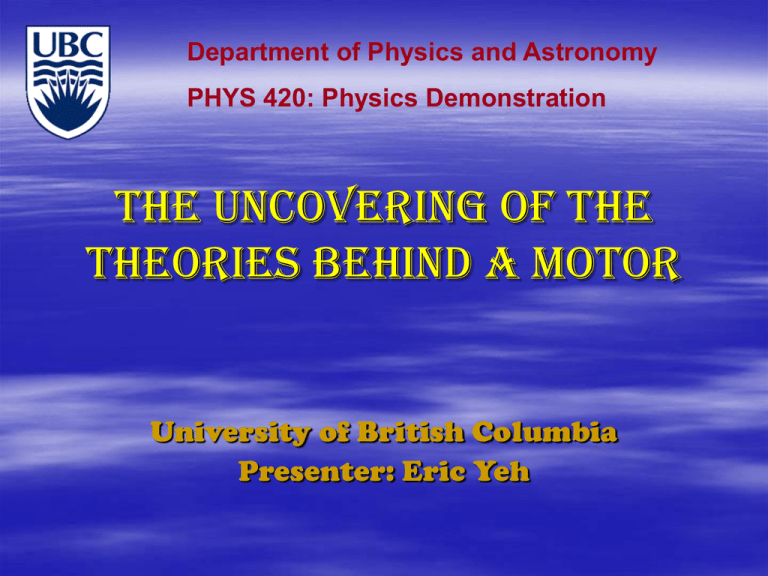Here is the PowerPoint slide that I presented to the IB Physics 12 class
advertisement

Department of Physics and Astronomy PHYS 420: Physics Demonstration THE uncovering of the theories behind a motor University of British Columbia Presenter: Eric Yeh What are we doing today? We are going to learn the basic functions, principles, and applications of an electric motor. We are also going to build a very simple motor today right here in this classroom. What is a Motor? Definition: A rotating machine that converts electrical power (either alternating current or direct current) into mechanical power. Is this definition very satisfying? The Types of Motor DC (Direct Current) Motor AC (Alternating Current) Motor Linear Motor Stepping Motor Reluctance Motor The type of motor that we are going to see today is a type of DC motor. Linear Motor A few countries are using powerful electromagnets to develop high-speed trains, called maglev trains. Maglev is short for magnetic levitation, which means that these trains will float over a guide way using the basic principles of magnets. How Does A Motor Do Work? There are couple main principles behind a working DC Motor. In simple terms, they are: Ampere’s Law Right Hand Rule The Magnetic Field & Force Torque & Power How Does A Motor Do Work? The Electromagnet Electromagnets are usually in the form of iron core solenoids. The iron nails line up with the smaller driving magnetic field produced by the current in the solenoid. This multiplies the magnetic field by factors of tens to even thousands. The solenoid field relationship is k is the relative permeability of the iron, shows the magnifying effect of the iron core. μ0 is the permeability of the air. The Electromagnet The Electromagnet The Magnetic Field The Current The Current The Force Theory Behind a Working Motor The Torque Our Demonstration today The Motor that We are Building Materials Required: One 'D' Cell Alkaline Battery 2 Pieces of Aluminum Tape Two Large Paper Clips One Rectangular Ceramic Magnet Heavy Gauge Magnet Wire (the kind with red enamel insulation, not plastic coated) Fine Sandpaper Optional: Glue, Small Block of Wood for Base The Motor that We are Building The Motor that We are Building Starting about 8 cm from the end of the wire, wrap it 7 times around the battery provided. Cut the wire, leaving a 8 cm tail opposite the original starting point. Wrap the two tails around the coil so that the coil is held together and the two tails extend perpendicular to the coil. On one tail, use fine sandpaper to completely remove the insulation from the wire. Leave about 0.5 cm of insulation on the end where the wire meets to coil. On the other tail, lay the coil down flat and lightly sand off the insulation from the top half of the wire only. Again, leave 0.5 cm of full insulation on the end and where the wire meets the coil. The Motor that We are Building Bend the two paper clips into the following shape Use the aluminum tape to hold the loop ends to the terminals of the "D" Cell battery Stick the ceramic magnet on the side of the battery as shown: The Motor that We are Building Place the coil in the cradle formed by the right ends of the paper clips. You may have to give it a gentle push to get it started, but it should begin to spin rapidly. If it doesn't spin, check to make sure that all of the insulation has been removed from the wire ends. The Applications of a Motor What about a Generator The current running through coils of wire would produce magnetic field that attracts or opposes the existing permanent magnet, which then drives the coil of wire to move or rotate. Reversely, coils of wire moves or rotates in a magnetic field would also produce a current. This is what a generate does. How Does a Generator Work A Simple Generator Demo A Simple Generator Demo A Simple Generator Demo We are going to try to rotate the center rod to create current with the effect of the magnetic field When we rotate the rod, we will use a voltmeter to test whether or not the current is produced. Also, the positive and negative current reading depends on the direction of the spin. Types of Generator? SYNCHRONOUS GENERATORS Synchronous generators are most often used for "emergency" or "standby" power, but in many cases may be used to provide all of the power requirements of a facility. INDUCTION GENERATORS Induction generators are most often used for "peak shaving" (providing the power needed for starting large motors, additional air conditioning load on hot days, etc.) How can Motors and Generators help us? With the theory of conservation of energy, we know that the energy will not disappear. Rather, energy would change from one form to another. In our discussion today, we have seen electrical energy turn into mechanical energy and also from mechanical to electrical. Motors would help us to utilize the electrical energy that we have to do work through the form of mechanical energy. Generator does the opposite. It transforms mechanical energy into electrical energy. Generator is able to provide us with the source of electricity when we provide other forms of energy or materials that could react to release energy. A Better Definition • Electric motors involve moving or rotating coils of wire which are driven by electric current producing magnetic force that opposes the magnetic field. They transform electrical energy into mechanical energy.






